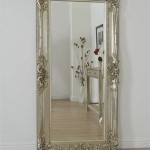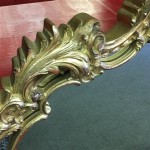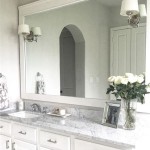Antique Large Mirrors: A Reflection of History and Elegance
Antique large mirrors hold a unique position in the world of interior design and historical artifacts. They offer more than just a reflective surface; they provide a glimpse into past eras, showcasing craftsmanship, artistic trends, and the social context of their creation. Their imposing size and often ornate frames command attention, becoming a focal point in any space they occupy.
The Allure of Size and Grandeur
The sheer scale of antique large mirrors contributes significantly to their appeal. These pieces often served a practical purpose in grand homes and palaces, maximizing natural light and creating an illusion of spaciousness. Today, this grandeur translates into a statement piece, adding drama and a sense of history to modern interiors.
Reflecting the Styles of the Past
Antique large mirrors reflect the various stylistic periods from which they originate. From the elaborate gilt frames of the Baroque and Rococo periods to the simpler lines of Neoclassicism and Art Deco, each era left its mark on mirror design. Identifying these stylistic elements allows collectors and enthusiasts to appreciate the mirror's historical context and place it within a specific design lineage. Key features to observe include frame materials (wood, gesso, metal), carving styles, and decorative motifs.
The Craftsmanship of Mirror Making
Creating large mirrors, especially in earlier centuries, was a complex and skilled undertaking. Before the advent of modern glassmaking techniques, producing large, clear panes of glass was a significant challenge. Early mirrors often utilized mercury-backed glass or other reflective surfaces, which can impact their appearance and value today. Examining the glass itself, looking for signs of age, imperfections, or particular manufacturing methods, can provide insights into the mirror's age and authenticity.
Framing the Reflection: The Art of the Frame
The frame of an antique large mirror is often as important as the mirror itself. Frames can be highly decorative, featuring intricate carvings, gilded surfaces, or inlaid materials like mother-of-pearl or tortoiseshell. The frame's style often dictates the overall aesthetic of the mirror and can significantly influence its value. Careful examination of the frame's construction, materials, and decorative elements is crucial for understanding the mirror's history and assessing its quality.
Placement and Impact in Interior Design
Incorporating an antique large mirror into a modern interior requires careful consideration of its size and style. These statement pieces can serve various functions, from creating a dramatic focal point above a fireplace mantel to adding light and depth to a smaller room. The mirror's frame should complement the surrounding décor, whether it's a period-specific setting or a more eclectic mix of styles. Properly placed, an antique large mirror can enhance the overall aesthetic of a room, adding a touch of history and elegance.
Conservation and Care
Preserving the beauty and integrity of antique large mirrors requires appropriate care and conservation practices. Avoid exposing the mirror to direct sunlight or excessive humidity, which can damage the frame and the reflective surface. Cleaning should be done with gentle, non-abrasive materials. For significant damage or restoration work, consulting a professional conservator is recommended to ensure the mirror's historical value and structural integrity are maintained.
The Investment Value of Antique Large Mirrors
Antique large mirrors can represent a significant investment, with their value influenced by factors like age, rarity, condition, and historical significance. Mirrors from specific periods or with documented provenance often command higher prices. The market for antique mirrors can fluctuate, so consulting with reputable antique dealers or appraisers is advisable for those considering purchasing or selling these valuable pieces.
Beyond Reflection: Mirrors as Historical Artifacts
Antique large mirrors are more than just decorative objects; they offer a tangible connection to the past. They reflect the tastes, technologies, and social customs of the eras in which they were created. Studying these pieces provides valuable insights into the history of interior design, craftsmanship, and the evolution of mirror-making techniques. Their presence in museums and private collections ensures that these historical reflections continue to fascinate and inspire for generations to come.

Large Antique Wall Mirror 1860s For At Pamono

2 738 Antique Mirrors For Ingantiques Co

780 Antique Large Mirrors For Ingantiques Co

Ornate Antique Gold Wall Mirror Large Decor Glass Mirrors Home Gifts Art Interior Gift Wood Frame

25 Sophisticated Antique Mirror Ideas For Your Home Digsdigs Elegant Entryway Tiles Living Room Mirrors

Antique Large Mirrors

Antique Large Mirrors

Large Antique French Mirror 234064 Ingantiques Co

Antiques Atlas Large 19th Century Gilt Wall Mirror As284a1470 Am92

Large French Painted And Gilt Mirror In Antique Floor Mirrors








